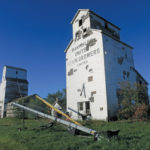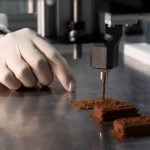
Grandview UGG_cmyk.jpg
A 35,000-bushel grain elevator in Grandview, seen here in 1969, was built around 1920 by United Grain Growers. An annex built during the Second World War was used for nearly 40 years. In 1953, a new 70,000-bushel elevator was built beside the older elevator, replacing a flour shed and coal bins at the site. A 125,000-bushel cribbed annex was built beside the new elevator in 1961 and, 10 years later, the older elevator was repaired and converted to an annex. The wartime annex was demolished in 1981 and later the old elevator annex. The remaining structure closed on July 1, 2000 and was demolished in late November 2000. Grandview’s last elevator, built in 1950 by Manitoba Pool, was demolished in November 2009.
Photo: University of Manitoba Archives & Special Collections
Barnsley Pool_cmyk.jpg
Two grain elevators at the former railway siding of Barnsley, in the RM of Dufferin north of Carman, were once operated by Manitoba Pool. “Pool B” (right) was constructed before 1916 by the provincial government as one of about 40 it built between 1910 and 1923 under the auspices of its Manitoba Elevator Commission. The elevator was leased to United Grain Growers in 1916 and sold to the Pool around 1959, which built “Pool A” (left) in 1928. The two elevators were closed in July 1972 and sold to a local farmer. Both are now in poor structural condition.
Photo: Gordon Goldsborough (September 2016)
Shortdale UGG_CMYK.jpg
An 82,000-bushel grain elevator at Shortdale, on the CNR Togo Subdivision in what is now the Municipality of Roblin, was built in 1933 by United Grain Growers. It was demolished in November 1995, one of the last vestiges of a once-thriving community that boasted a blacksmith, three general stores, pool hall, two dance halls, school, and 200 inhabitants. The last buildings were destroyed by a grass fire in April 2007.
Photo: UGG Photo Collection, U of M Archives
Neepawa UGG_CMYK.jpg
When this United Grain Growers elevator at Neepawa was photographed in 1961, it was surrounded on three sides by annexes, giving it a total capacity of 152,000 bushels. Three annexes were built as emergency storage space in August and September 1940, during the Second World War, when Nazi submarines threatened grain shipments overseas. Many of the annexes remained in service for decades and were cursed by generations of elevator agents. One of the wartime annexes was torn down in 1948, a second in 1978, and a third in 1980. The elevator, built in 1938, was demolished in November 2002.
Photo: UGG Fonds, University of Manitoba Archives & Special Collections
In the 1950s, there were over 700 grain elevators in Manitoba. Today, there are fewer than 200. You can help to preserve the legacy of these disappearing “Prairie sentinels.”
The Manitoba Historical Society (MHS) is gathering information about all elevators that ever stood in Manitoba, regardless of their present status. Collaborating with the Manitoba Co-operator it is supplying these images of a grain elevators in hopes readers will be able to tell the society more about it, or any other elevator they know of.
MHS Gordon Goldsborough webmaster and Journal editor has developed a website to post your replies to a series of questions about elevators. The MHS is interested in all grain elevators that have served the farm community.
Read Also

Province pledges funds to CentrePort Canada
The Manitoba government has pledged $450,000 towards projects at inland port CentrePort Canada.
Your contributions will help gather historical information such as present status of elevators, names of companies, owners and agents, rail lines, year elevators were built — and dates when they were torn down (if applicable).
There is room on the website to post personal recollections and stories related to grain elevators. The MHS presently also has only a partial list of all elevators that have been demolished. You can help by updating that list if you know of one not included on that list.
Your contributions are greatly appreciated and will help the MHS develop a comprehensive, searchable database to preserve the farm community’s collective knowledge of what was once a vast network of grain elevators across Manitoba.
Please contribute to This Old Grain Elevator website here.
You will receive a response, by email or phone call, confirming that your submission was received.
Goldsborough is especially interested in determining when elevators were demolished. Readers with photos of elevator demolitions and dates of when these occurred can contact him directly at [email protected] or call 204-782-8829.





















